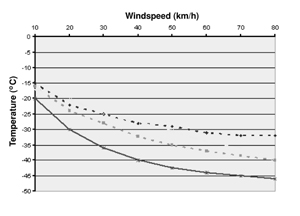

 
|
|
|
|
|
||
|
|

Chilling Out
Anyone who has ever waited at a bus stop or taken a walk on a blustery winter day knows that when the wind blows it feels colder than it really is. Although the sensation of wind chill is nothing new, recent studies show that many people are still confused by what it means, and that the formula we use to determine it may be exaggerating its effects. What makes wind chill so hard to get a handle on is that it can't be measured by an instrument. It simply describes a sensation: the way we feel as a result of the combined cooling effect of temperature and wind. what makes wind chill so hard to get a handle on is that it can't be measured by an instrument. Normally our bodies warm up a thin layer of air close to our skin that protects it from external temperatures. In cold weather, when the wind blows it takes this layer with it, and replaces it with cold air. Your body then has to work harder to warm up a new protective layer. If these layers keep getting blown away, your skin temperature will drop-something that could lead, in below-zero conditions, to frostbite. The formula most commonly used to determine wind chill (known as the Siple-Passel formula) was devised more than 50 years ago by Antarctic explorers who measured how long it took for a plastic cylinder of water to freeze at various temperatures and wind speeds. There are several inherent flaws in the formula-including the fact that the human body produces its own heat and that wind speeds are measured at weather stations 10 metres above ground, where they are generally faster than at body height. As a result, the method may be estimating wind chill as colder than it really is. In addition, the lack of a standard way of reporting wind chill, even within Canada, has led to some confusion. Although meteorologists support the use of wind-chill factor, which describes the rate of heat loss in watts per square metre, many people don't understand the meaning of the numbers in the scale-which range from 800 to over 2000. The media and most members of the public prefer equivalent temperature, which likens the way it feels to the temperature on a calm day. Problem is, people may confuse equivalent temperature with actual temperature and believe there is a danger of freezing water pipes or plants, even when the actual temperature is above zero-something that is physically impossible unless evaporative cooling from a wet surface is involved. As one of only four countries that issue wind-chill information operationally (the United States, Great Britain and Finland are the others), Canada took the lead in the debate over wind chill when Environment Canada's Meteorological Service of Canada held the first-ever international workshop on wind chill this past April. The workshop, which took place over the Internet, had over 400 registrants from 35 countries. Most participants agreed on the need for an international standard for measuring and reporting wind chill, but ideas about exactly what it should measure are split into two camps. Supporters of a whole-body model believe apparent temperature should combine the effects of ambient temperature, humidity, wind, solar radiation, and metabolic heat production on an average person to determine the amount of clothing needed to equate heat loss with heat production. Proponents of a facial-cooling model, on the other hand, argue that the effect of wind chill is felt primarily on the face, so that measures should focus on exposed skin. Opinions are also divided about whether wind chill should be expressed in terms of temperature units or a non-dimensional scale or set of categories. 
Graph showing wind chill equivalent temperatures calculated using Siple-Passel formula (solid line) and two other more recent methods (dotted lines) at an actual temperature of -15ºC. As a result of the workshop, the International Society of Biometeorology has struck an international commission of 14 scientists to prepare recommendations for a Universal Thermal Climate Index, in which index ranges could be predicted using the necessary variables, from the hottest to the coldest ends of the scale. The commission, which is co-chaired by Environment Canada, will present its findings to the World Meteorological Organization in the spring of 2001, with an eye to having a new wind-chill formula in place by the winter of 2002. |
|
|
Home | Air | Atmospheric Science | Climate Change | Environmental Action | Habitat | Pollution | Species at Risk | Technology | Water | Weather | Wildlife |
|
|
| Help
| Search
| Canada Site |
|
||
|
The Green LaneTM, Environment Canada's World Wide Web site
|
||
|
|
||
|
|
||